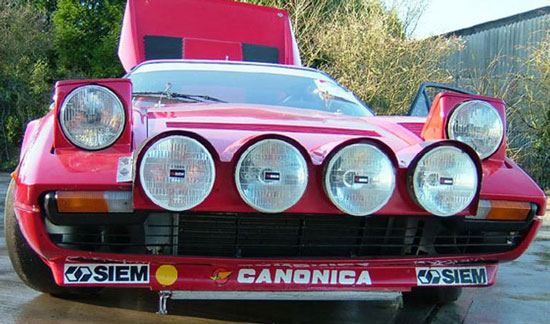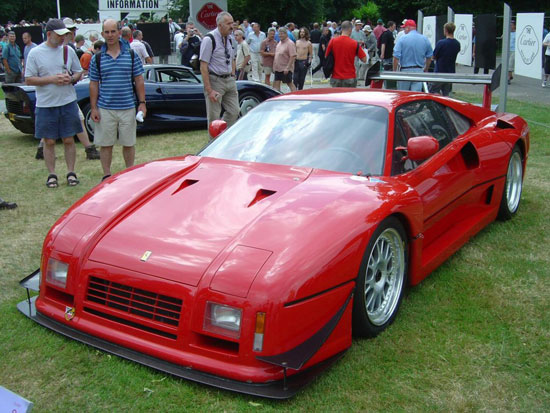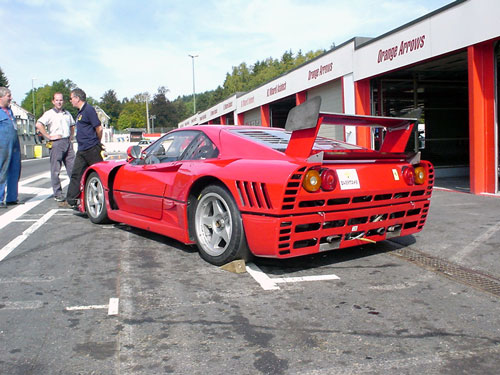Ferrari 308 GTB Michelotto

- Ferrari 308 GTB
- Homologation: 01.10.1982 (B220)
- Homologation: 01.01.1983 (B236)
- Ferrari 308 Quattrovalvole
- Homologation: 01.04.1983 (B241)
- Layout: Mid Engine (Transverse), RWD
- Weight: 980 kg
- Top Speed: 159 mph
- Cars Produced: 15 (11 Gp4, 4 GpB)
- Engine: 2927cc V8
- Induction: Naturally Aspirated
- Power: 288hp
- Engine: 2927cc V8 Quattrovalvole
- Heads: DOHC 32 valve
- Induction: Naturally Aspirated
- Fuel: Bosch K-Jetronic
- Power: 310bhp @ 8000rpm
Ferrari’s series production 308 had never been conceptualised with motor sport in mind, however, a handful of interesting competition cars were produced and went onto compete successfully around Europe. Most were built up by Michelotto of Padova who not only received authorisation from the factory but also got a good deal of back door assistance. The machines prepared by Michelotto and Ferrari for racing fall into three categories, Group 4, Group B and GT/M cars.
For 1983, the FIA brought in their new Group B regulations forcing Michelotto to develop a qualifying version of the 308. Because a batch of 25 highly modified GTB Evolution's was more or less out of the question, the specification of these Group B contenders wasn't allowed to change that much from the standard road car. The most significant development from previous Group 4 cars was Michelotto's choice of the Quattrovalvole engine as their starting point. Somewhat curiously, however, the first car was fitted with an older two-valve head rather then the QV unit as used on the subsequent three cars.
There was rose-jointed suspension all-round and more powerful Brembo brakes, new Canonica wheels and Pirelli rubber coming fitted as standard although both these were routinely changed. The forced substitution of those beautiful Campagnolo wheels for narrower, more standard looking five-spoke Canonica’s led to a reduction in track compared to the Group 4 spec cars. Three of the Group B 308's were fitted with QV four-valve engines that produced 310bhp at 8000rpm, the first car (chassis 18869) using a 288bhp two-valve motor. The mechanical Kugelfischer fuel injection of Group 4 cars was changed to electronic Bosch K-Jetronic while, overall, the Group B variants came out some 30kg heavier because of their stock GRP and steel body panels. Just four were constructed by Michelotto over the winter of 1982/’83 to participate in various European Group B rally championships.
Info copied from: http://www.qv500.com/ferrari308p6.php
The four Michelotto cars were raced by the Italian Rally team Pro Motor Sport. Chassis 22409 (pictured) was very successful in multiple major rallies, winning the Marca Trevigiani and Città de Bassano, driven by Giulio and Pasutti respectively, coming in second in both the Targa Florio and Isola d'Elba driven by Battistolli; and second again in the Príncipe de Asturias driven by Tognana. Chassis 18869 and 18971 both won 1st place in the Sicillian Rally Championship in '83 and '84 respectively. Chassis 18847 had 2nd place finish at the '84 Della Lana.

Ferrari 288 GTO
he Ferrari GTO was built to compete in the new Group B Race series and a minimum of 200 cars were required for homologation. However as only Ferrari and Porsche, with their 959, entered, the series was soon abandoned leaving just the Group B Rally championship. The Porsche 959 {961} only raced three times in Group B, but the 288 GTO never raced and all 272 cars built remained purely road cars.
- Ferrari 288 GTO
- Homologation: 01.06.1985 (B273)
- Class: Under 4000cc (2855cc x 1.4 = 3997cc)
- Layout: Mid Engine (Longetudinal), RWD
- Weight: 1220kg
- Wheelbase: 2450 mm
- Top Speed: 190mph
- Cars Produced: 277
- Engine: 2855cc V8
- Fuel: Weber-Marelli fuel injection
- Induction: Forced (Twin IHI turbos @ 11psi)
- Compression: 7.6:1
- Power: 400hp
- Torque: 366ft/lbs
The GTO was based on the mid-engined 308 GTB. The 288 refers to its 2.8 liter V8 engine, though, as it used a de-bored (by 1 mm) V8 with twin IHI turbochargers, intercoolers, and Weber-Marelli fuel injection. The 2855 cc engine capacity was dictated by the FIA's requirement for a Turbocharged engine's capacity to be multiplied by 1.4. This gave the GTO a theoretical engine capacity of 3997 cc, just under the Group B limit of 4.0 litres.
Unlike the 308, the engine was mounted longitudinally, using the 308's rear boot space. The wheelbase was 110 mm (4.3 in) longer at 2450 mm (96.5 in), and the track was widened also. With 400 hp (almost 140 hp per liter) and 366 ft·lbf (496 N·m) of torque, the GTO was an impressive performer. 0-60 mph times were in the upper 4 second range and Ferrari claimed 0-125 mph (201 km/h) in 15 seconds flat. Top speed was a staggering 190 mph (306 km/h)
Ferrari 288 GTO Evoluzione

Special attention must go to Ferrari's five awesome development vehicles built to take the GTO concept to it's limit. Designated GTO Evoluzione's, these experimental cars were originally conceptualised as the 288 competition variants that would contest Group B. However, they later took on the role of mobile test beds for the technology that would be incorporated onto 1987's F40. With the Evoluzione, Ferrari greatly increased their use of composite panels on a chassis that was still closely related to the 288 (steel tubes and composite reinforcements).
Higher cabin sill extensions were especially noticeable from within the cockpit and were retained for the F40. The first engine plumbed into an Evoluzione was designated Tipo F114 CR and featured the turbo pressure cranked up to 1.4 bar (compared to 0.8 bar for road car), compression being increased to 7.8:1 from the 288's 7.6:1. These changes alone resulted in a reliable power hike to 530bhp at 7500rpm. The R in it's engine designation referred to the fact that these units were originally intended for use in Rallying - a site that is hard to imagine with the mass produced sedans that dominate WRC events today. The next development, Ferrari's Tipo F114 CK (K to designate a circuit engine) featured an even further enhanced specification. Thanks to larger diameter IHI turbochargers, power soared to a Grand Prix-rivalling 650bhp at 7800rpm! Combine such figures with the ultra light 940kg weight (the original 288 GTO weighed in at 1220kg) and a cocktail of almighty performance was complete. Depending on gear ratios, a top speed of 225mph was reputedly possible while sprinting from zero to 125mph took less than ten seconds. As was becoming commonplace in top level competition cars, composite panels were used for the entire Evoluzione shell, the lines of which had significantly evolved from the lithe elegance of Pininfarina's original 288.

- Ferrari 288 GTO Evoluzione
- Homologation: Prototype
- Weight: 294kg
- Top Speed: 255mph
- Cars Produced: 5
- Name: Tipo F114 CR
- Engine: 2855cc V8
- Induction: Forced (Twin IHI turbos @ 20psi)
- Fuel: Weber-Marelli fuel injection
- Compression: 7.8:1
- Power: 530hp @ 7500rpm
- Name: Tipo F114 CK
- 2855cc V8
- Induction: Forced (Twin IHI turbos)
- Fuel: Weber-Marelli fuel injection
- Power: 650bhp @ 7800rpm
The nose seemed to have been influenced Pininfarina's Series II and III BB LM's, the Michelotto 308 GT/M's of 1984/’85 and perhaps most surprisingly, the Facetti-modified Group 5 308 CARMA. Deeper side skirts minimised air flow underneath the car, the only really obvious similiarties with the 288 having come around the doors, windscreen and cockpit sides. As had been the case at the front, the rear bodywork was fashioned purely with function in mind, a multitude of ducts and louvres finding their way onto the doors, screen, deck and wings.
250 GTO-style louvres were cut deep into the rear wings while a phenomenal array of vents were located on the rear quarters and perspex screen, many of many of which went on to be used for the F40. The aero pack was completed by a huge fully adjustable rear wing complimented, at it's base, by a supplementary gurney flap. As you would have expected, the interior was bereft of anything considered unnecessary in the pursuit of ultimate performance. The only similarity to the original 288 cabin was the instrument binnacle, everything else having been subtly redesigned and later incorporated more or less directly into the legendary F40. Ferrari had originally intended for 25 GTO Evoluzione's to be constructed, that number being FISA's minimum requirement for qualification of race legal Evoluzione's should Ferrari have wanted to participate in Group B circuit or rally racing with the car. In fact though, only five were ever built and only 2 of those exist today.
Info Copied from: http://www.qv500.com/ferrari288p2.php
